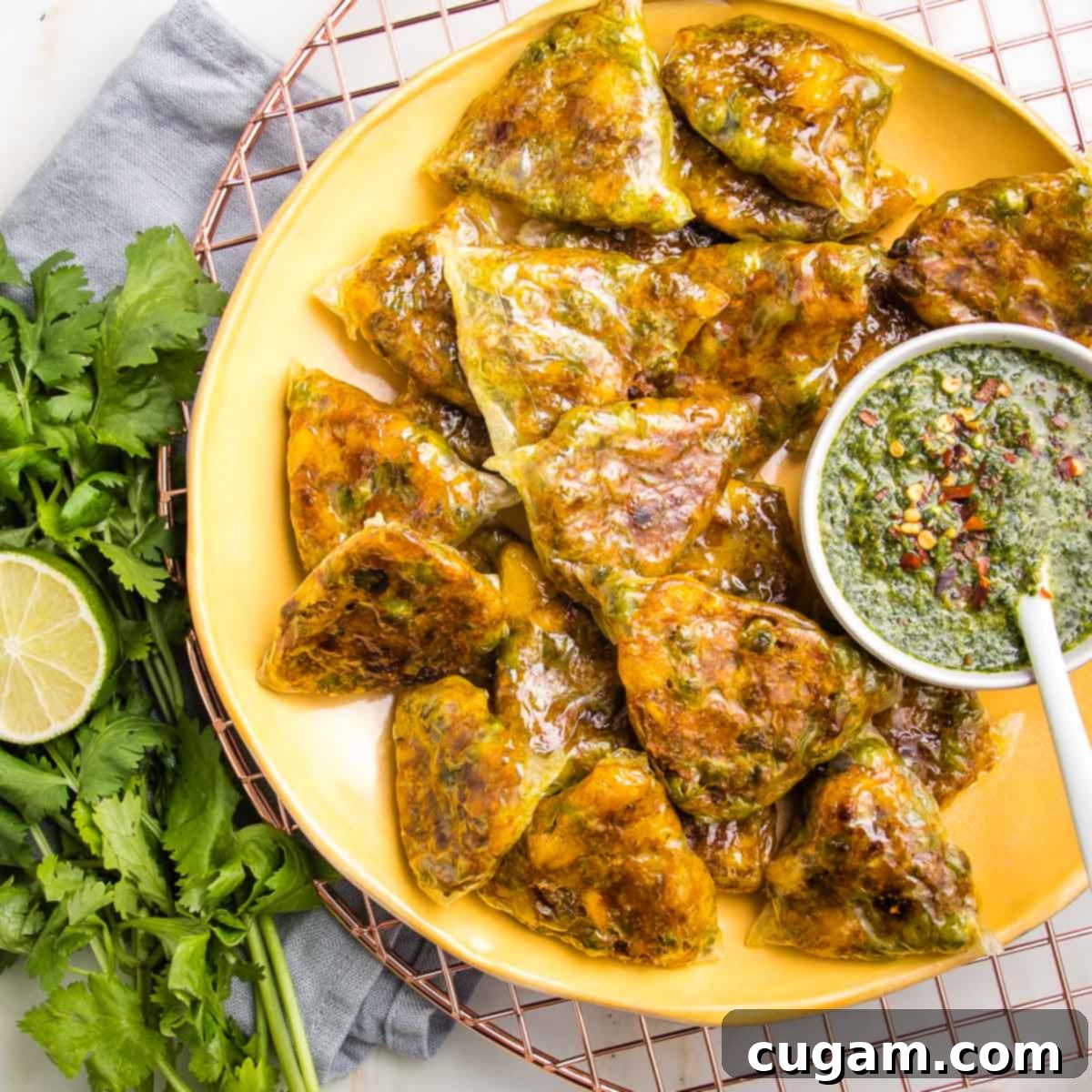Crispy Baked Vegan Samosas with Rice Paper Wrappers: An Easy Gluten-Free Indian Appetizer
Discover the secret to incredibly easy, crispy, and flavorful vegan samosas without the fuss of traditional dough! This revolutionary recipe uses rice paper wrappers, transforming a beloved Indian appetizer into a quick, gluten-free, and healthier baked delight. Filled with perfectly spiced potatoes and peas, these samosas are served best with a vibrant homemade green chutney. Get ready to impress your taste buds and your guests!
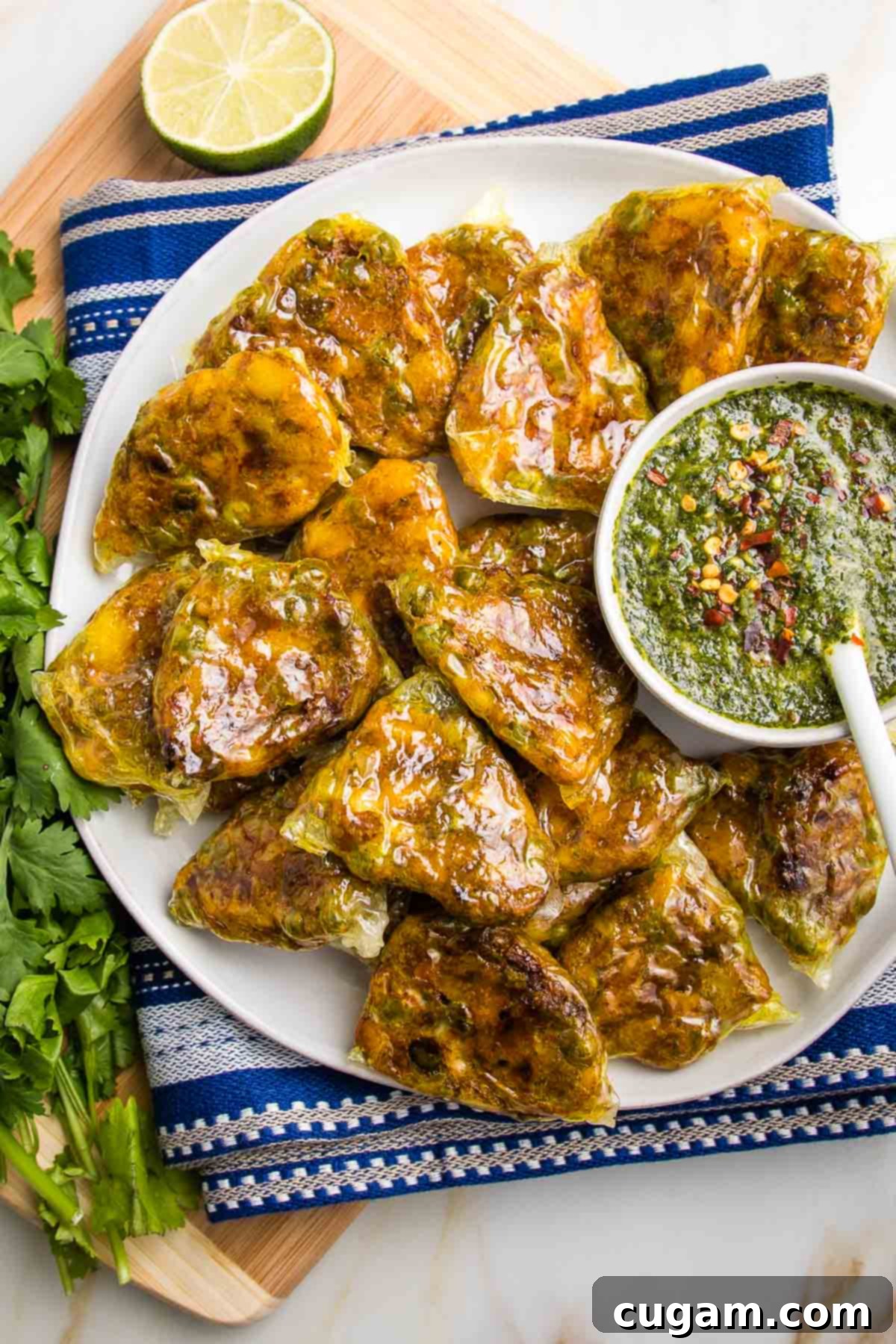
[feast_advanced_jump_to]
Why You’ll Love These Easy Baked Samosas
Craving the authentic taste of Indian samosas but want a healthier, simpler alternative? Look no further! These baked vegan samosas are a game-changer. They capture all the savory, aromatic flavors of restaurant-style samosas, but are entirely plant-based, gluten-free, and surprisingly quick to make. Forget the hours spent on kneading dough or the guilt of deep-frying. Our innovative approach uses delicate rice paper wrappers, which bake up incredibly crispy and light, offering a delightful crunch with every bite. This recipe is perfect for anyone seeking a delicious, wholesome appetizer that doesn’t compromise on flavor or ease.
The Brilliance of Rice Paper Wrappers for Samosas
Traditionally, samosas are made with a flour-based pastry dough that is often deep-fried. While undeniably delicious, this process can be time-consuming and heavy. Our solution? Rice paper wrappers! This ingenious swap makes homemade samosas accessible to everyone, regardless of their baking skills or dietary restrictions. Here’s why rice paper is a superstar in this recipe:
- Effortless & Quick: No kneading, no rolling, no resting dough. Simply dip, fill, and fold!
- Gluten-Free: Naturally free from gluten, making these samosas suitable for those with celiac disease or gluten sensitivities.
- Healthier Option: Baked, not fried, significantly reducing the oil content and making them a lighter appetizer.
- Incredibly Crispy: When baked, rice paper transforms into a wonderfully crisp and delicate shell, mimicking the satisfying texture of traditional samosas.
- Widely Available: Rice paper wrappers are readily found in most major grocery stores in the Asian foods aisle or can be easily ordered online.
Key Ingredients for Healthy Samosas
Creating these flavorful vegan samosas requires a handful of simple, wholesome ingredients. Each component plays a crucial role in building the authentic taste and perfect texture of our baked Indian appetizer. Here’s a closer look at what you’ll need:
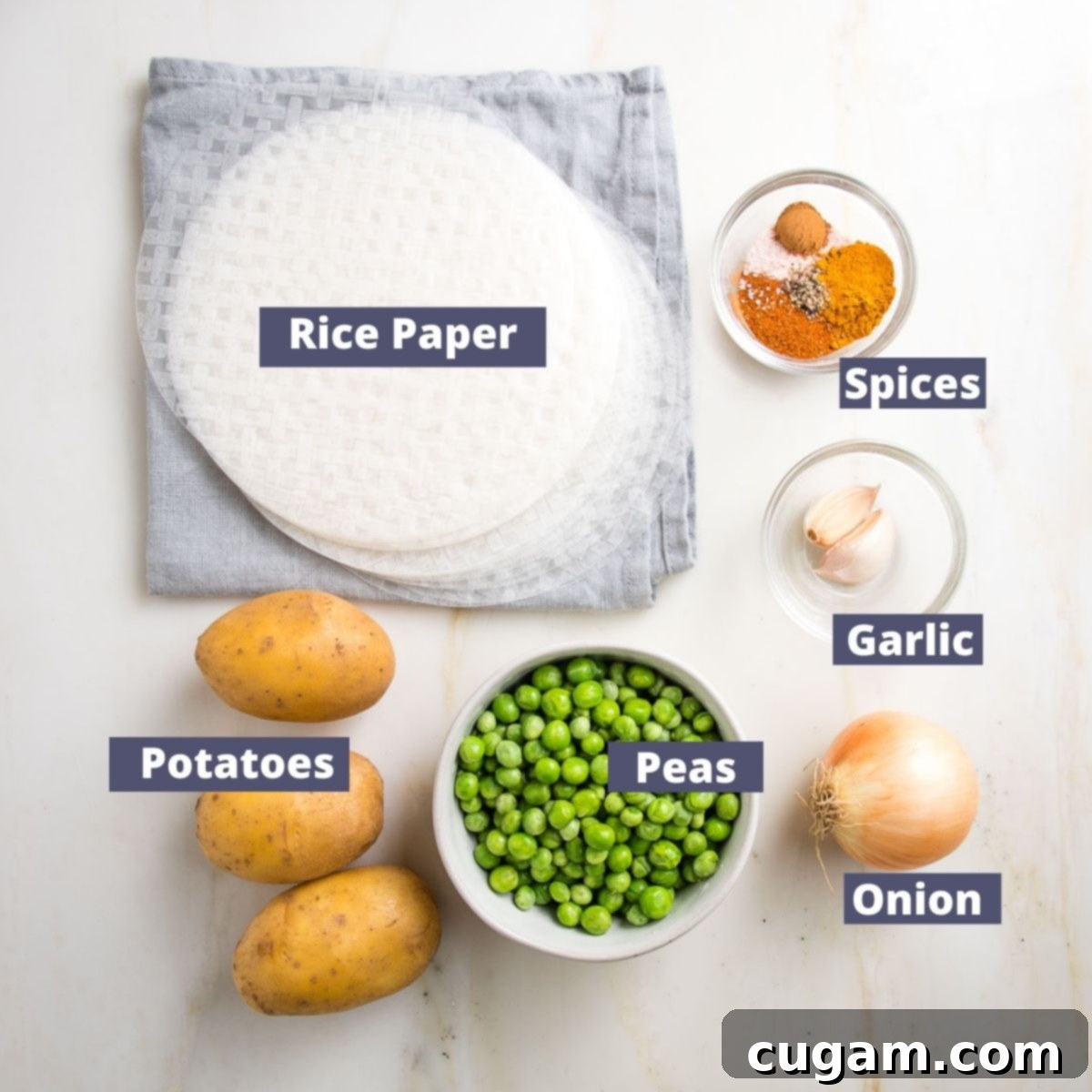
- Rice Paper Wrappers: The star of our easy samosa recipe! Opt for brands made primarily from rice flour, tapioca starch (or cassava root flour), and water. These typically yield the best pliability and crispy texture when baked. Always check the ingredient list for gluten-free certification if necessary. You can easily find rice paper wrappers at your local grocery store or online.
- Potatoes: Yukon Gold potatoes are highly recommended for their creamy texture and ability to mash beautifully, providing a smooth yet hearty base for the samosa filling. Their slightly sweet flavor complements the spices perfectly. However, feel free to use any potato variety you have on hand, including red potatoes or even sweet potatoes for a different flavor profile. Remember, peeling is optional!
- Green Peas: Frozen green peas are a convenient and nutritious addition. They add a pop of vibrant color, a hint of sweetness, and a lovely texture to the spiced potato filling. Peas are also a good source of fiber, vitamins, and antioxidants.
- Onion: A finely diced onion (white, yellow, or red) forms the aromatic foundation of the filling, lending essential depth of flavor when sautéed with garlic and spices.
- Garlic: Freshly minced garlic is indispensable for its pungent aroma and robust flavor, contributing to the authentic Indian taste while also offering immune-boosting benefits.
- Spices: The heart and soul of any good samosa!
- Turmeric: Provides that signature golden color and boasts powerful anti-inflammatory properties.
- Chili Powder: Adds a gentle warmth and subtle heat. Adjust to your preference for a spicier kick.
- Cumin: Earthy and aromatic, cumin is a cornerstone of Indian cuisine, contributing a distinct and delicious flavor.
- Cinnamon: A small amount adds a surprising hint of sweetness and warmth, rounding out the spice blend.
- Black Pepper: Not just for flavor, black pepper enhances the absorption of curcumin from turmeric, maximizing its health benefits.
- Sea Salt: Essential for balancing and amplifying all the other flavors in the filling.
- Optional Fresh Cilantro: Stirred in at the end, fresh cilantro adds a bright, herbaceous note that elevates the overall flavor profile of the potato and pea samosa filling.
Crafting the Perfect Samosa Filling
The delicious heart of our vegan samosas is the spiced potato and pea filling. It’s incredibly easy to prepare and packed with authentic Indian flavors. Follow these steps for a perfectly seasoned, creamy, and flavorful mixture:
Step 1: Prepare the Potatoes
Begin by thoroughly scrubbing your potatoes. There’s no need to peel them if you prefer a rustic touch and extra nutrients from the skin. Cut the potatoes into large, uniform dice. Place them in a small saucepan and cover with enough water to fully submerge them. Bring the water to a boil, then reduce the heat to a simmer. Cook, uncovered, for approximately 20 minutes, or until the potatoes are fork-tender but not mushy. This ensures they’ll mash easily while still holding some texture.
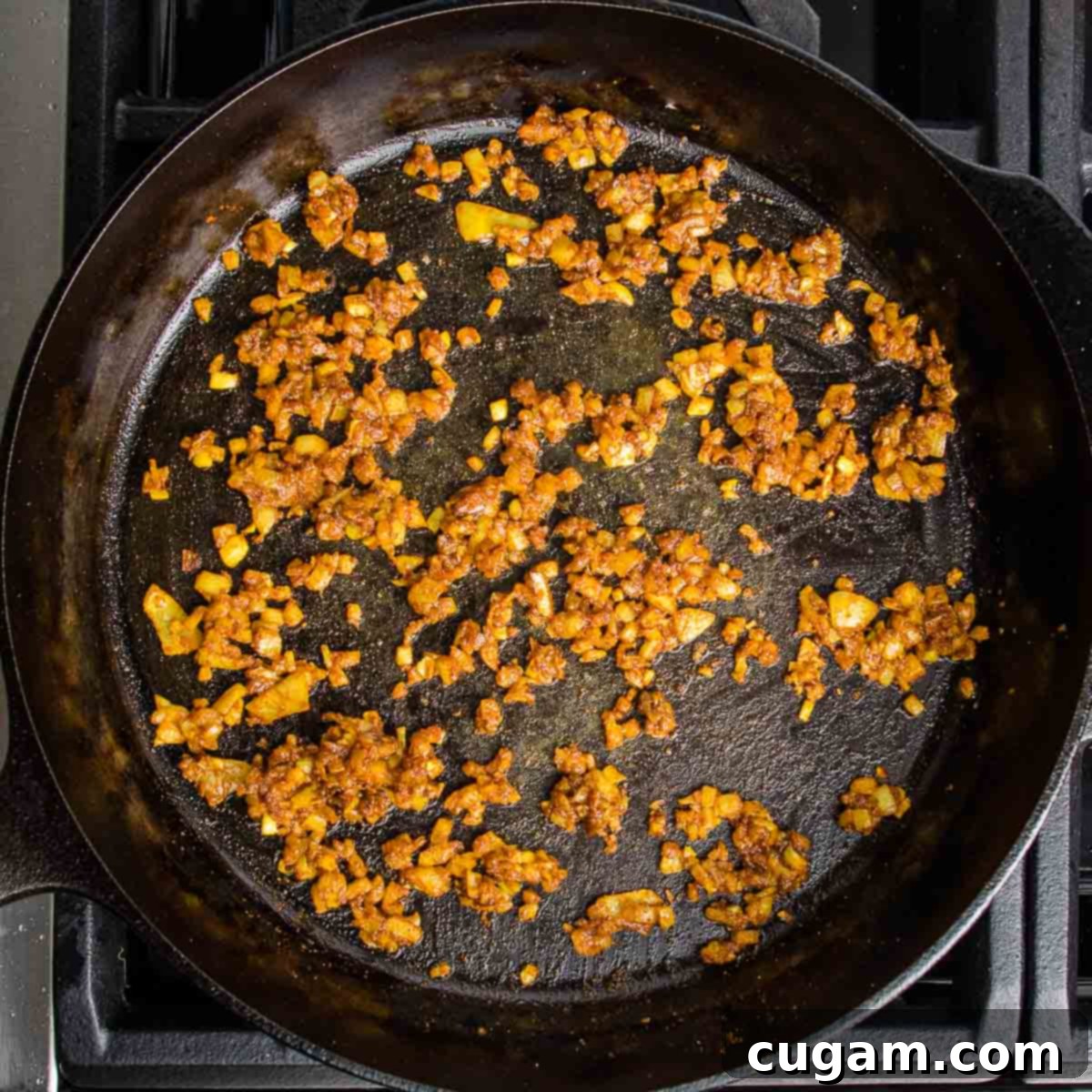
Step 2: Sauté Aromatics and Spices
While the potatoes are cooking, heat a heavy skillet (a cast iron skillet works wonderfully) over medium heat. Add 1-2 tablespoons of water or olive oil to sauté the diced onions. Cook for 3-5 minutes, stirring occasionally, until the onions begin to soften and become translucent. Next, sprinkle in the minced garlic, ground turmeric, chili powder, cinnamon, sea salt, and black pepper. Stir constantly for about 1 minute, allowing the garlic to cook and the spices to become incredibly fragrant. If the pan seems too dry, add another tablespoon of water to prevent burning. Turn off the heat once the spices are aromatic.
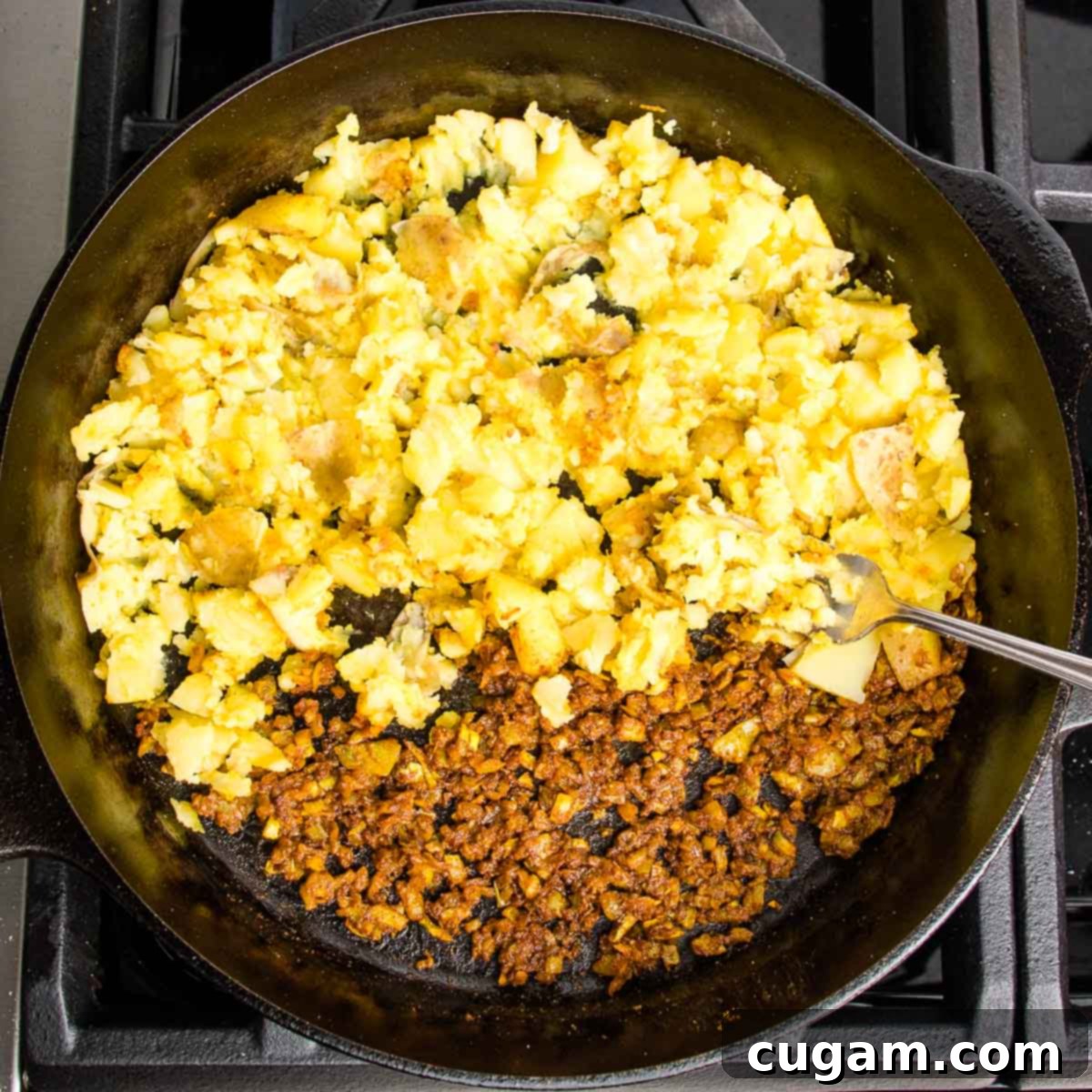
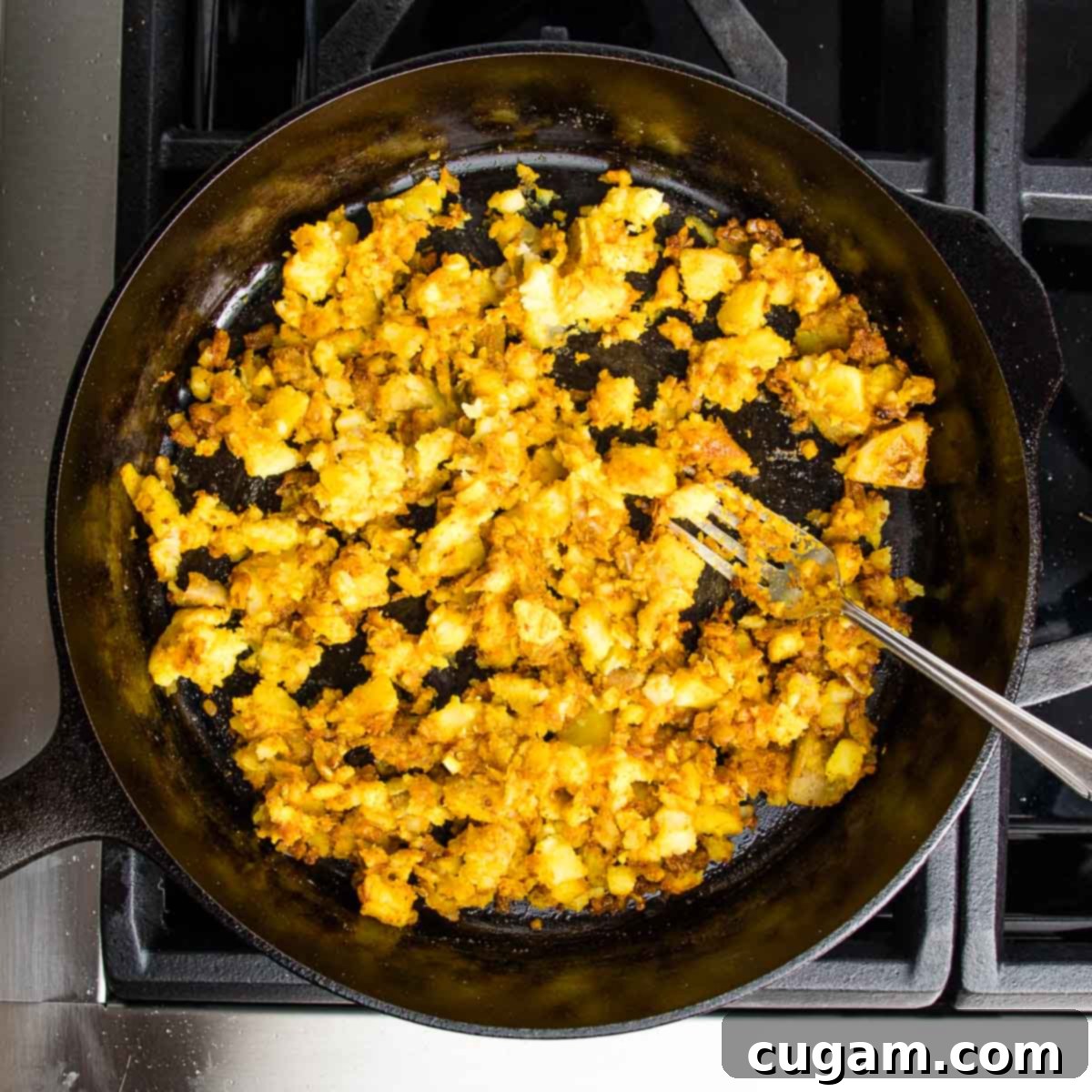
Step 3: Combine and Mash
Once the potatoes are tender, drain them thoroughly. Add the drained potatoes directly to the skillet with the sautéed onion and spice mixture. Using a fork, gently mash the potatoes, simultaneously incorporating them into the fragrant onion and spice blend. You want a somewhat coarse mash, not a completely smooth puree, to retain some texture in the samosas.
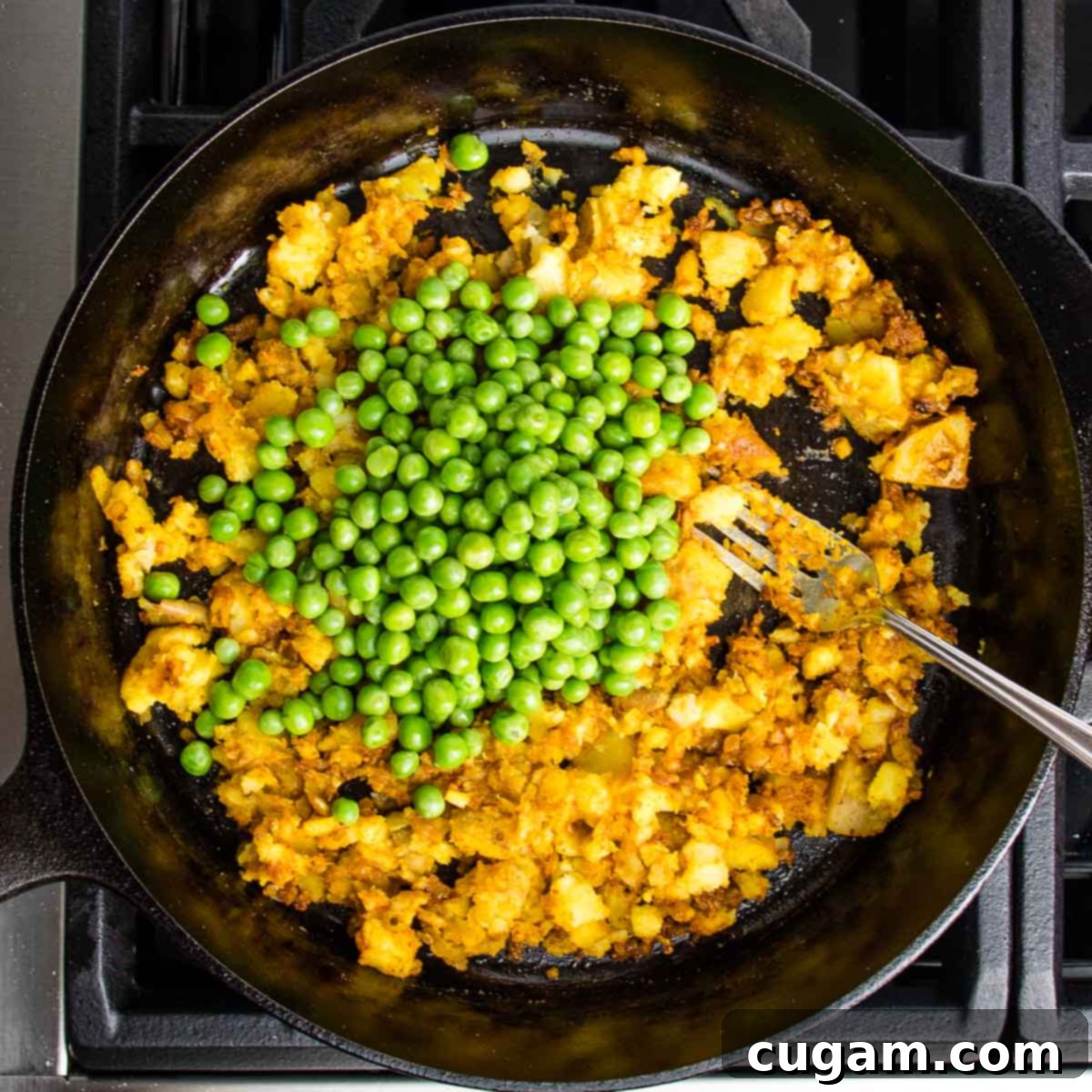
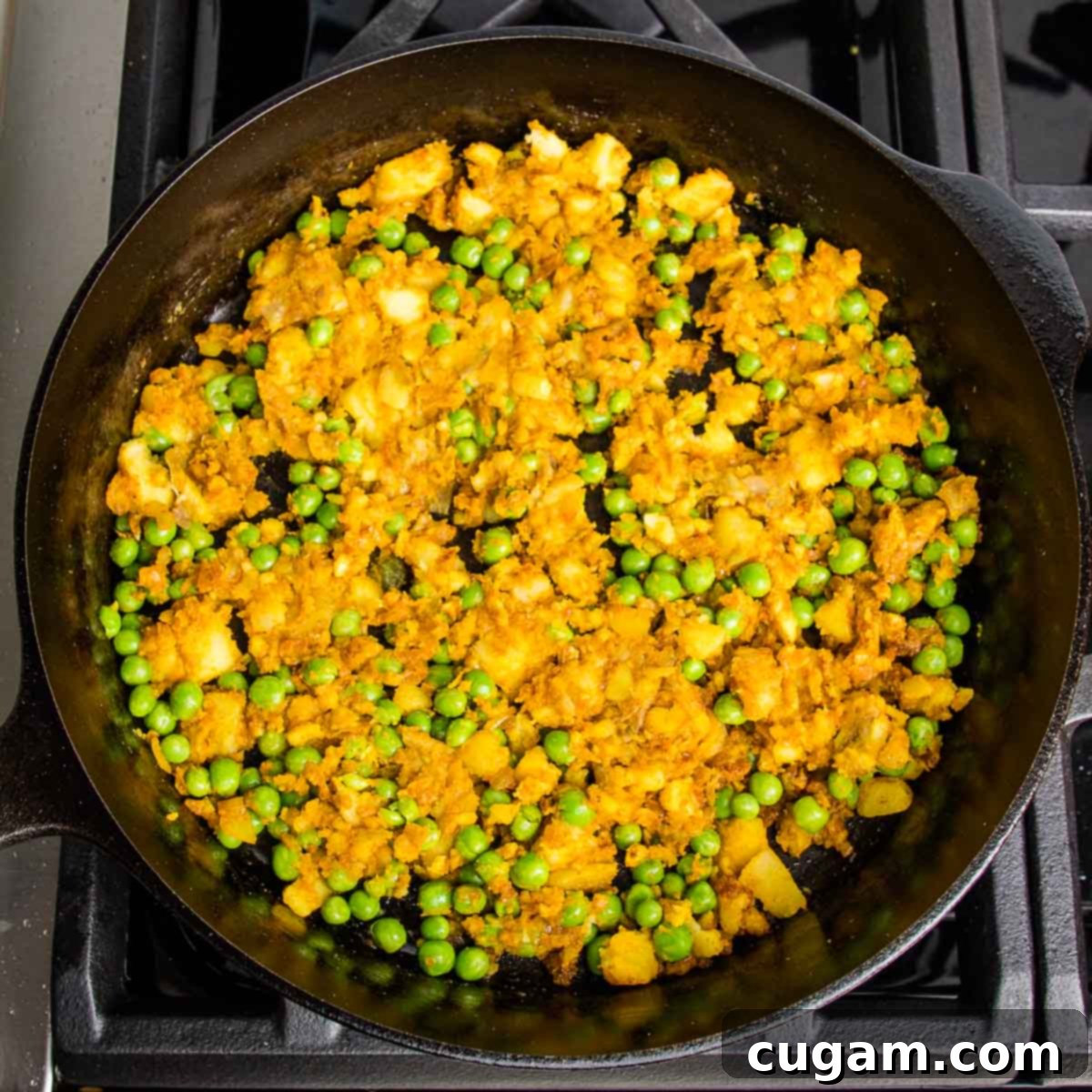
Step 4: Add Peas and Finish
Finally, gently fold the frozen peas into the potato mixture. The residual heat from the potatoes will warm them through. If using, stir in the optional fresh cilantro. Taste the filling and adjust seasonings if needed – perhaps a pinch more salt or a dash of chili powder for an extra kick. Now, your flavorful samosa filling is ready to be wrapped!
Gathering Your Samosa Assembly Station
Before you begin the exciting process of filling and folding your vegan samosas, it’s crucial to have all your tools and ingredients laid out and ready. Working with rice paper wrappers requires a little speed and organization, as they become quite pliable and sticky once wet. This “mise en place” will ensure a smooth and enjoyable samosa-making experience.
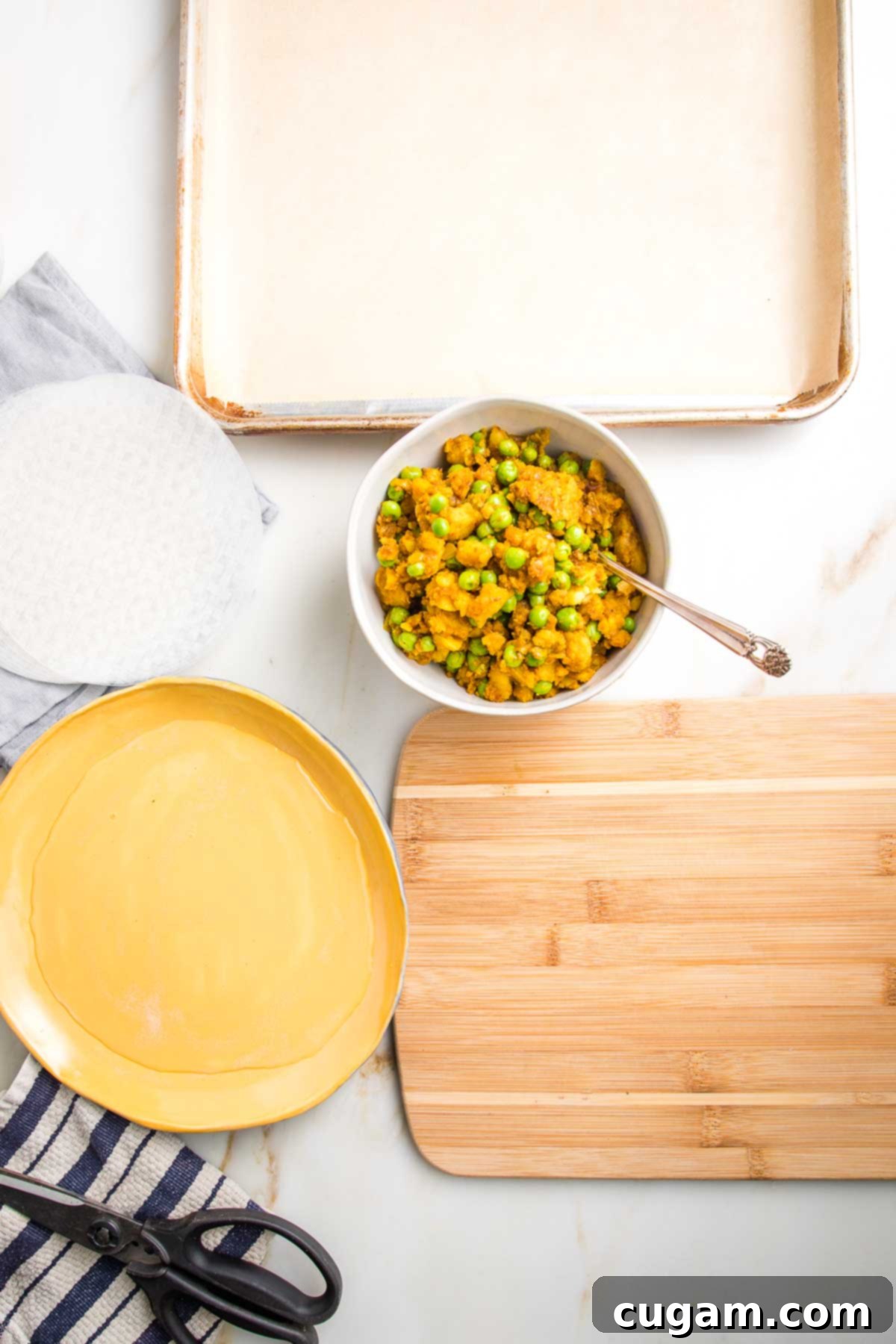
Preheat your oven to 400 degrees Fahrenheit (200°C) before you start. Then, set up your workstation with the following:
- A large rimmed baking sheet, meticulously lined with unbleached parchment paper. This prevents sticking and ensures easy cleanup.
- A sturdy wooden cutting board or a clean, smooth work surface. This provides a non-stick area for folding the delicate wrappers.
- A shallow dish, such as a pie plate or a large dinner plate, filled with about ¼ inch of warm water. This is for softening the rice paper wrappers.
- Sharp kitchen scissors for cutting the wrappers.
- Your stack of fresh rice paper wrappers.
- The prepared, cooled samosa filling.
- A clean dish towel. This is essential for dabbing excess water from the wrappers and keeping your fingers dry. (Pro tip: use an old towel, as turmeric can sometimes stain!)
Assembling Your Crispy Rice Paper Samosas
Now for the fun part: transforming the seasoned potato filling into perfectly shaped samosas! Working with rice paper is quick and easy, but it does require a gentle touch and a bit of speed. Here’s a detailed guide to folding your baked samosas:
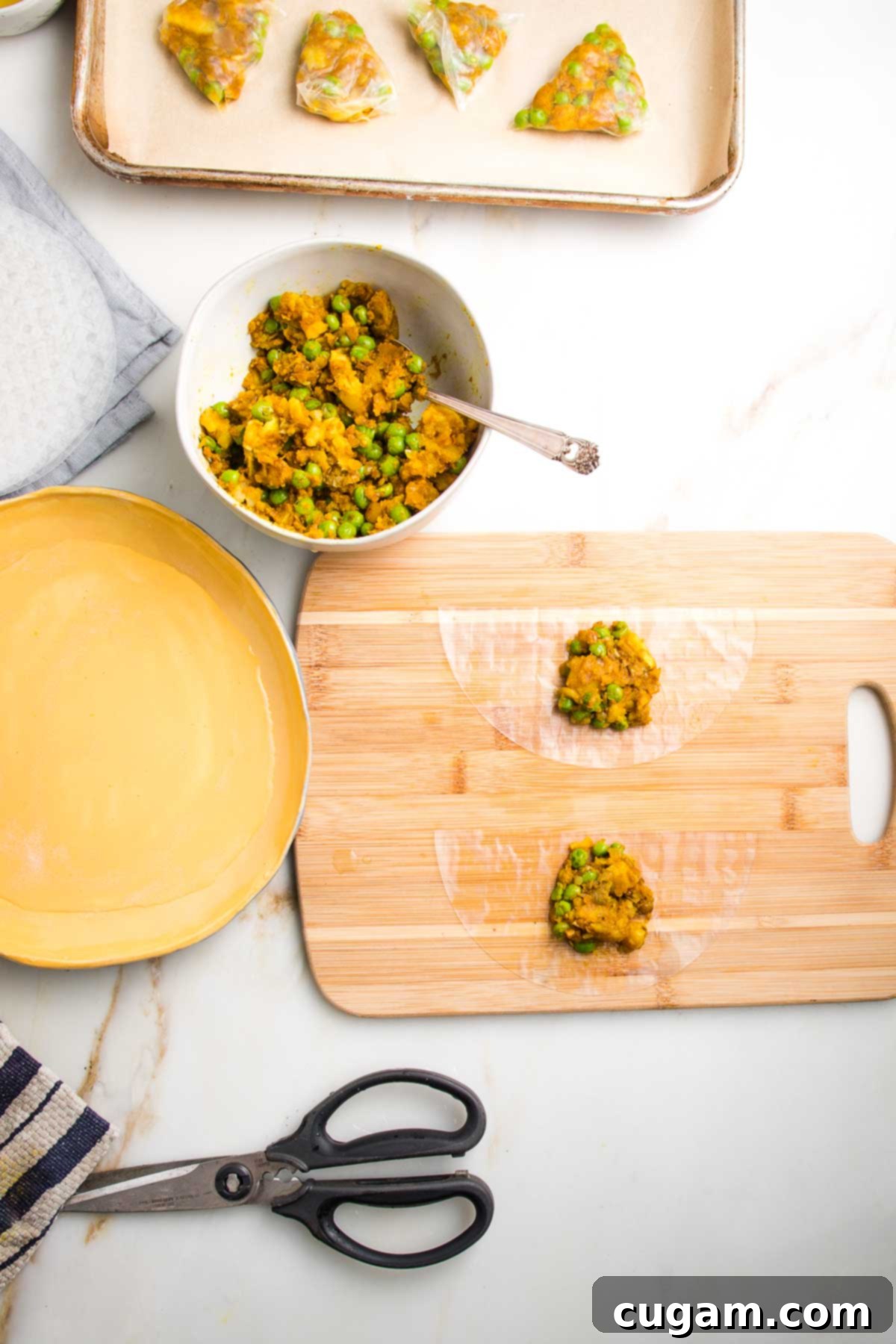
Step 1: Soften the Rice Paper
Carefully dip one rice paper wrapper into your prepared dish of water. Let it soak for about 5 seconds. Then, flip it over, ensuring it’s fully submerged for another 10 seconds. The goal is to make it pliable and flexible enough to cut and fold without tearing, but not so saturated that it becomes excessively sticky and hard to handle (like cling wrap). It should be soft but still have some structure.
Step 2: Cut and Position
Once softened, gently lift the wrapper from the water and tap it onto your dish towel to remove any excess dripping water. This quick dab prevents the wrapper from becoming too sticky too soon. Using your kitchen scissors, carefully cut the circular wrapper in half, creating two “half-moon” shapes. Place both halves onto your wooden board with the flat, cut edge at the top and the rounded side at the bottom.
Step 3: Fill the Wrapper
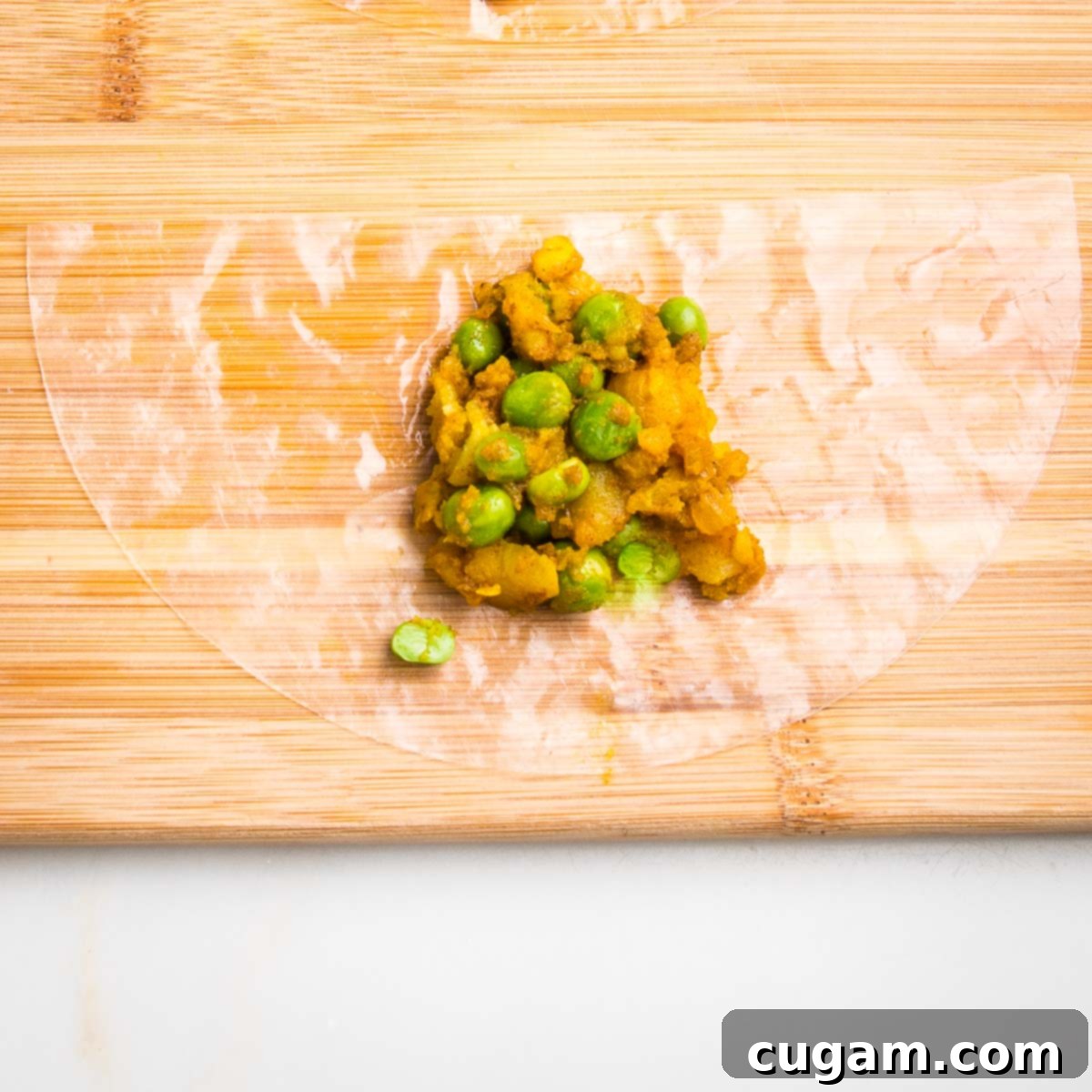
Scoop a generous tablespoon (or slightly more for larger samosas) of the prepared potato and pea filling onto the center of each half-moon. You’ll need to work relatively quickly, completing the folding process for one half, then moving to the next, before the rice paper becomes too tacky to manage.
Step 4: The First Fold
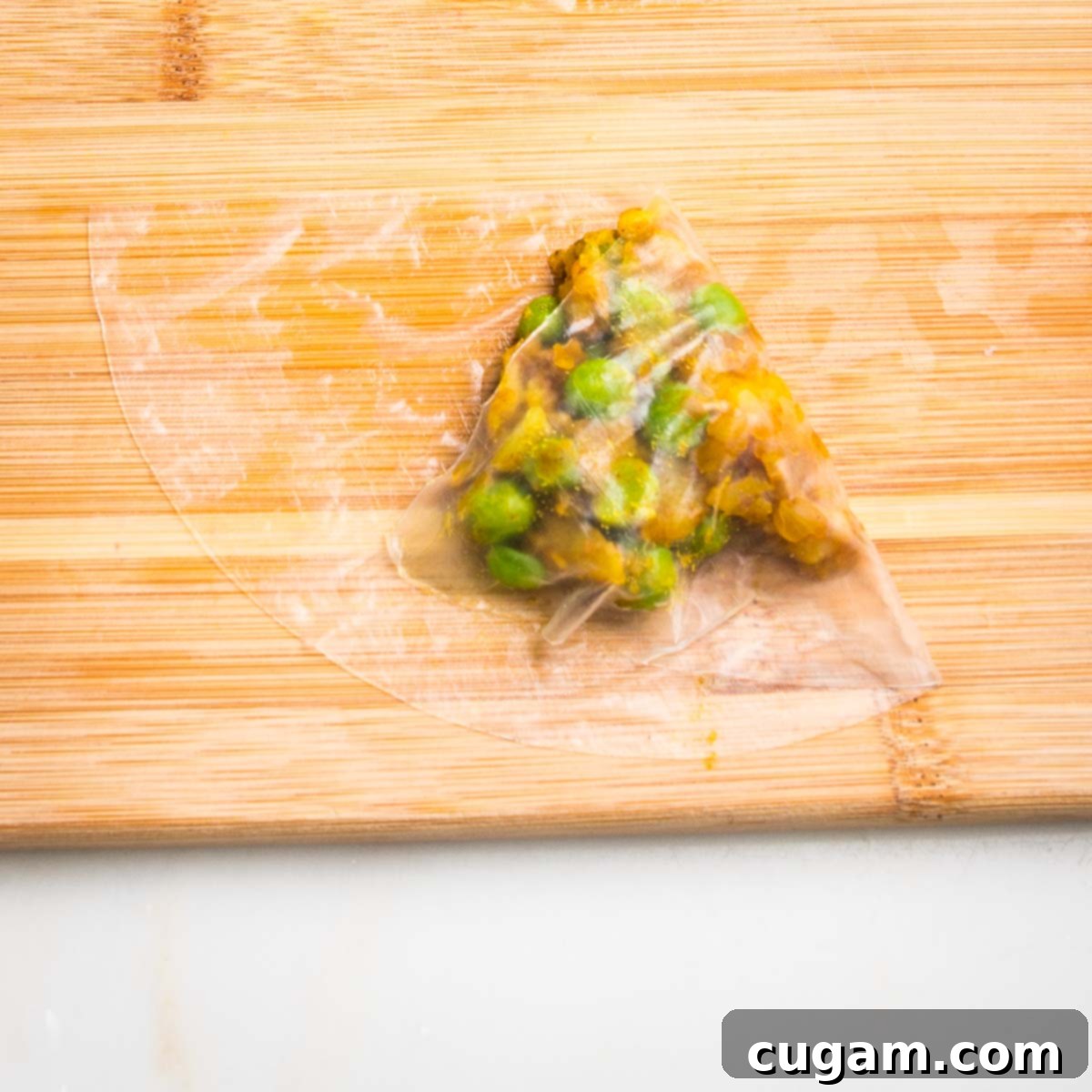
Take the top right corner of the half-moon wrapper and fold it down diagonally towards the opposite side’s bottom curve, as illustrated in the image. This begins to form the characteristic triangle shape of a samosa.
Step 5: Complete the Triangle
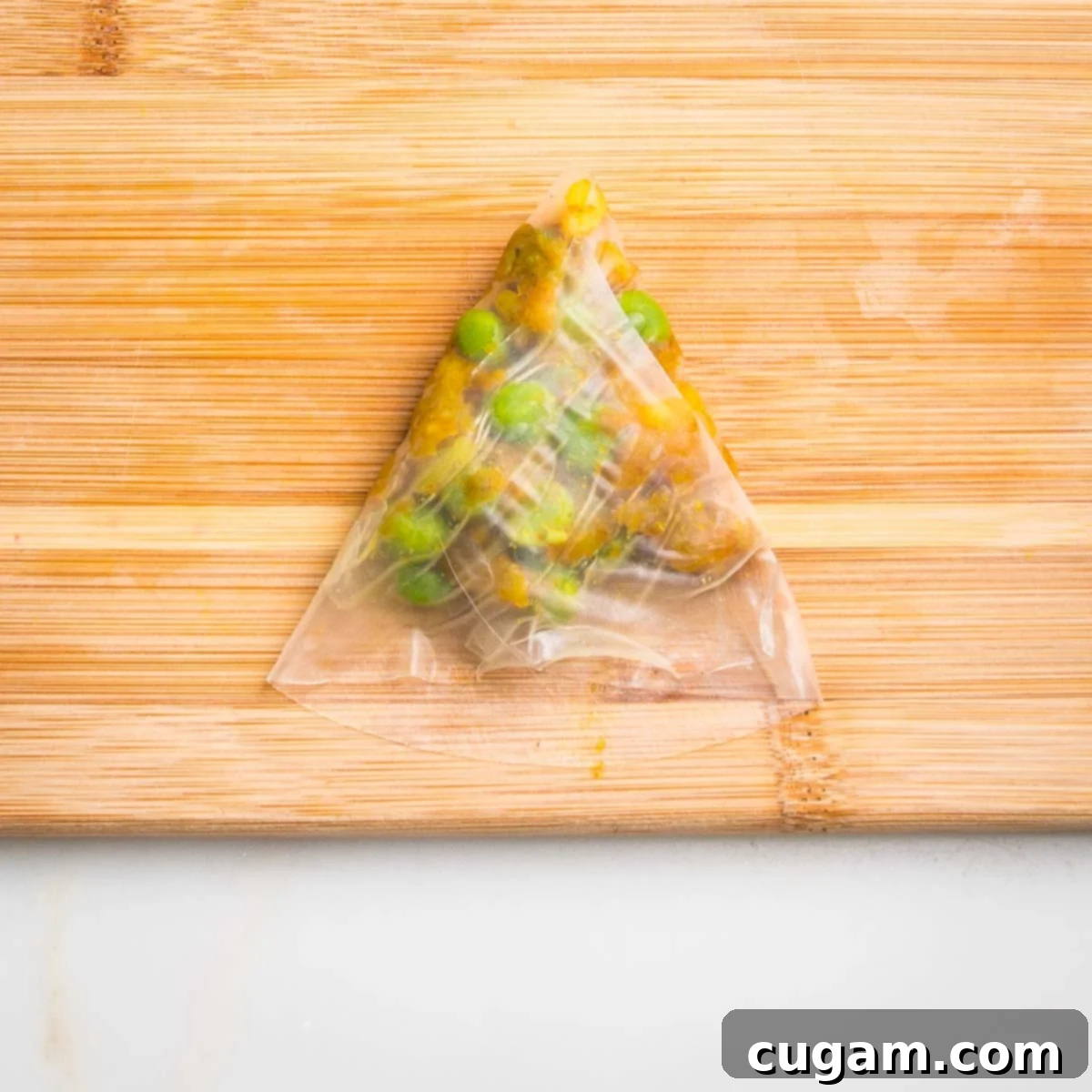
Next, take the top left corner and fold it down towards the right bottom, aligning it with the diagonal edge you just created. This action should bring the edges together, neatly encapsulating the filling and forming a clear triangle shape.
Step 6: Seal the Samosa
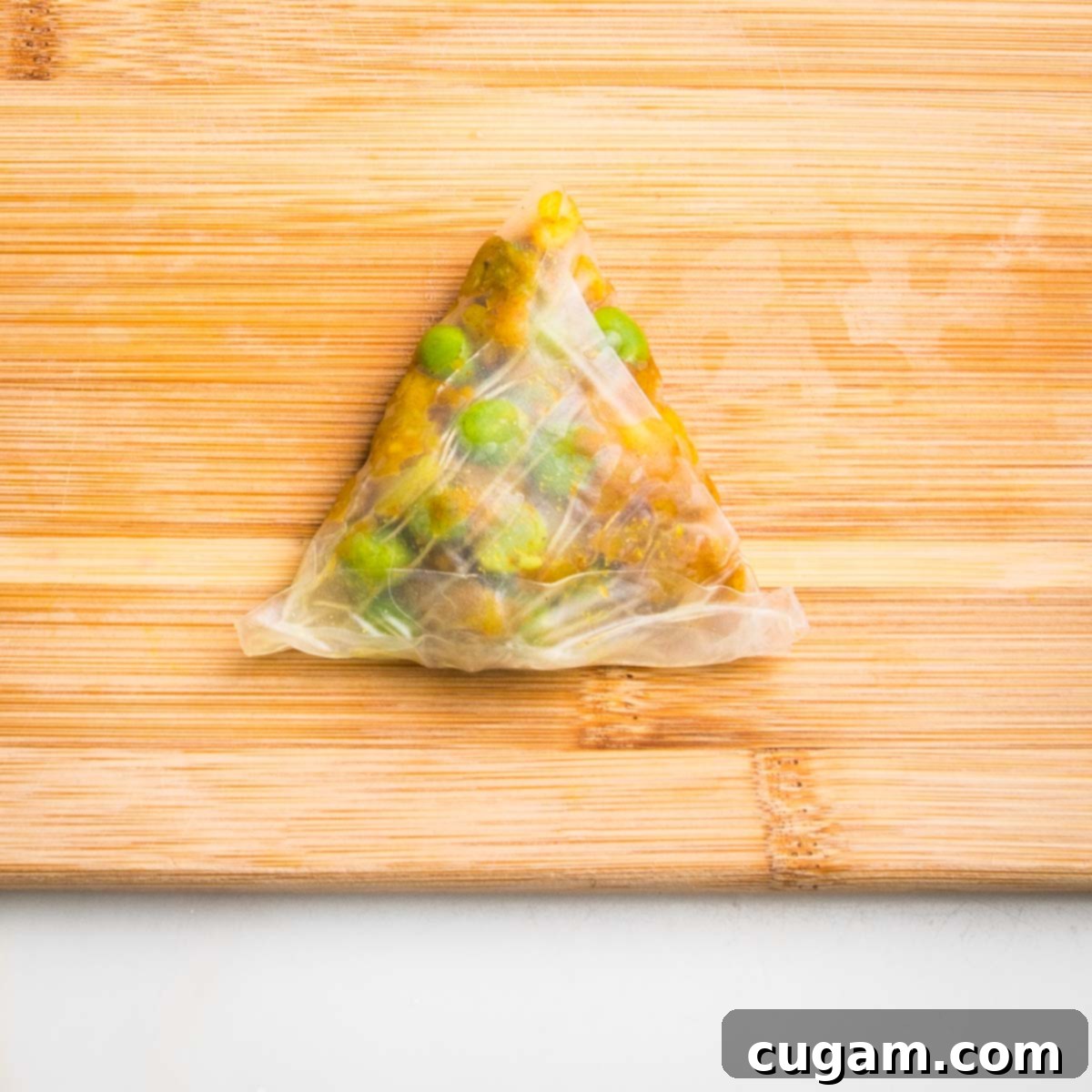
Finally, fold up the remaining bottom edge of the wrapper over the filling to completely seal the samosa. Press gently along all edges to ensure it’s securely closed. The goal is to create a sealed triangle, though a perfectly uniform shape is less important than making sure the filling is contained and the wrapper is sealed on all sides to prevent leakage during baking.
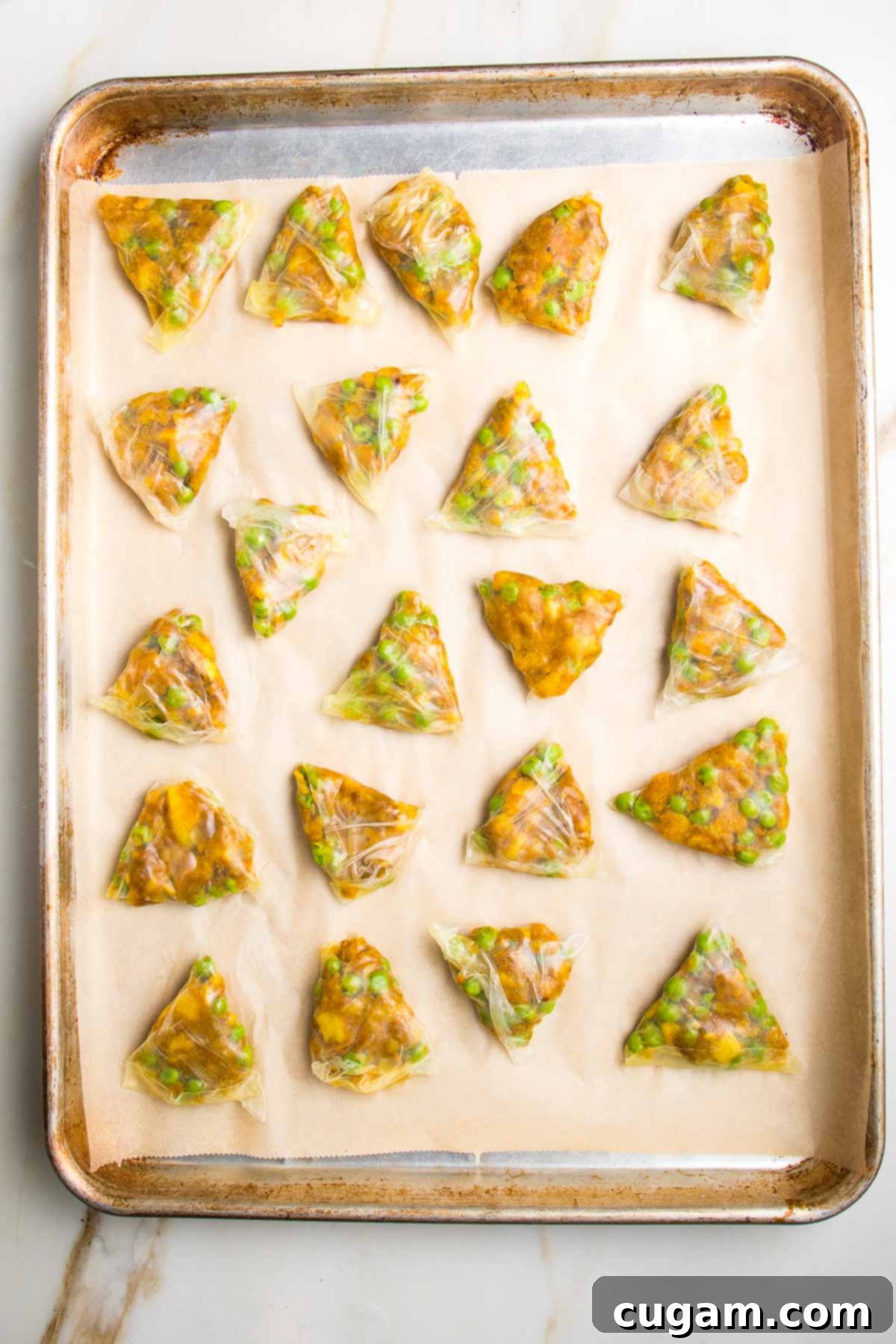
Step 7: Bake to Crispy Perfection
As soon as each samosa is folded and sealed, gently place it onto your prepared baking sheet lined with parchment paper. Don’t worry about spacing them too far apart; they may shrink slightly but will largely maintain their shape and size in the oven. Once all the samosas are assembled, place the tray in the preheated 400°F (200°C) oven and bake for 20 minutes. Then, carefully flip each samosa over and bake for an additional 10 minutes, or until they are golden brown and wonderfully crispy. Serve these delicious baked vegan samosas immediately for the best texture and flavor!
The Perfect Companion: Zesty Green Chutney
No samosa experience is complete without a flavorful dipping sauce, and this vibrant green chutney is the ideal accompaniment. Its fresh, tangy, and slightly spicy notes perfectly complement the rich, spiced potato filling of the samosas. The best part? You can whip it up in minutes while your samosas are baking!
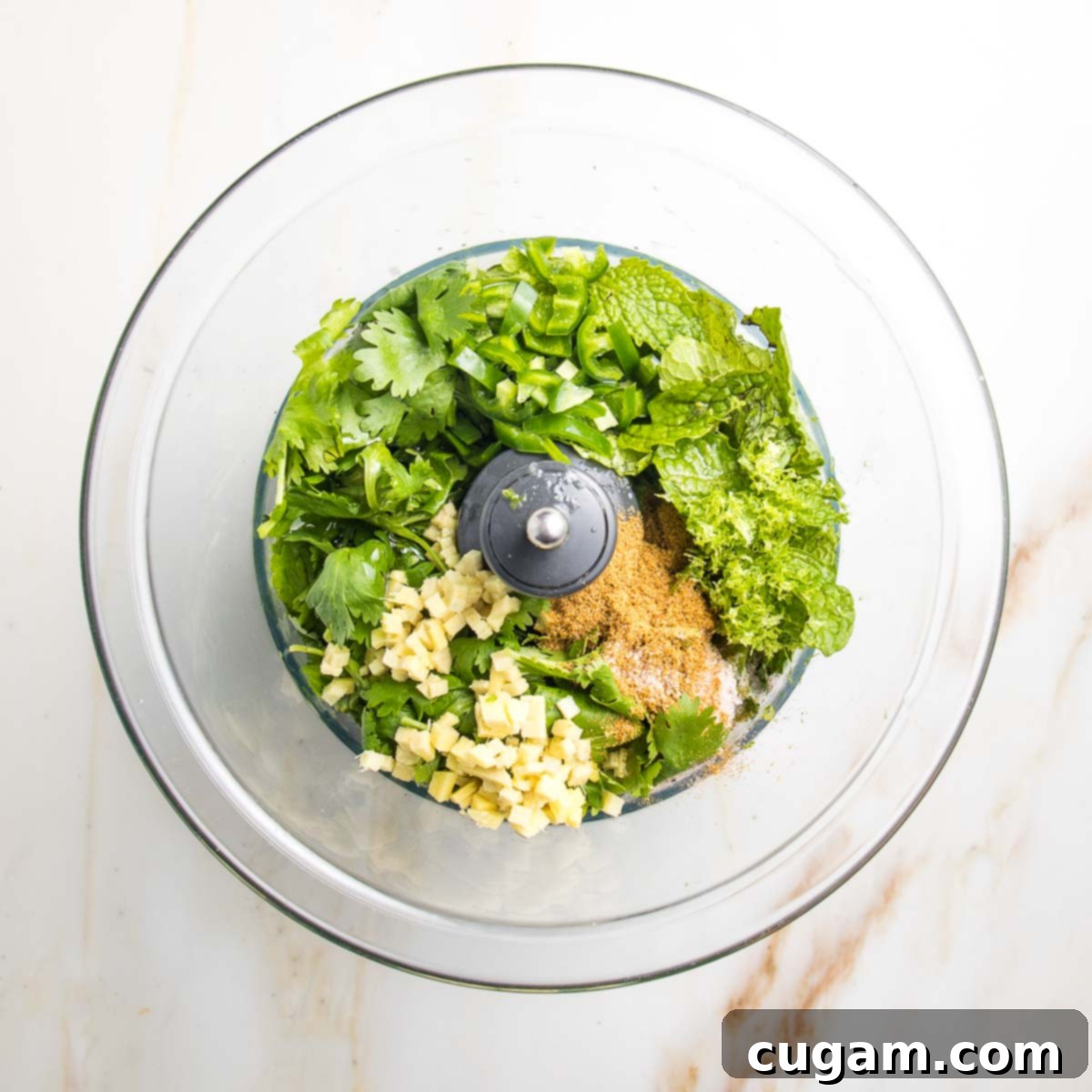
Ingredients for Green Chutney:
- 2 cups fresh cilantro (woody stems removed)
- 1 cup fresh mint leaves
- 1 lime (zested and juiced)
- 2 tablespoons honey or maple syrup (for vegan option)
- 1 tablespoon diced fresh ginger
- 1-2 fresh jalapeños (remove seeds for less heat, adjust to taste)
- 1 ½ teaspoons ground cumin
- 1 teaspoon sea salt
- 1-2 tablespoons water (for consistency)
Instructions:
Simply combine the fresh cilantro, mint, jalapeño, ginger, lime zest and juice, cumin, sea salt, and honey or maple syrup into the bowl of a food processor or a high-speed blender. Pulse and blend until the mixture is thoroughly combined and relatively smooth. Add 1-2 tablespoons of water, one tablespoon at a time, until the chutney reaches your desired dipping consistency – it should be thick enough to cling to the samosas but still pourable. Taste and adjust seasonings as needed: add more lime juice for tang, more sweetener for balance, or an extra piece of jalapeño (or a pinch of red pepper flakes) if you prefer a spicier kick. This green chutney not only tastes incredible but also adds a beautiful burst of color to your appetizer spread!
Pro Tips for Samosa Success
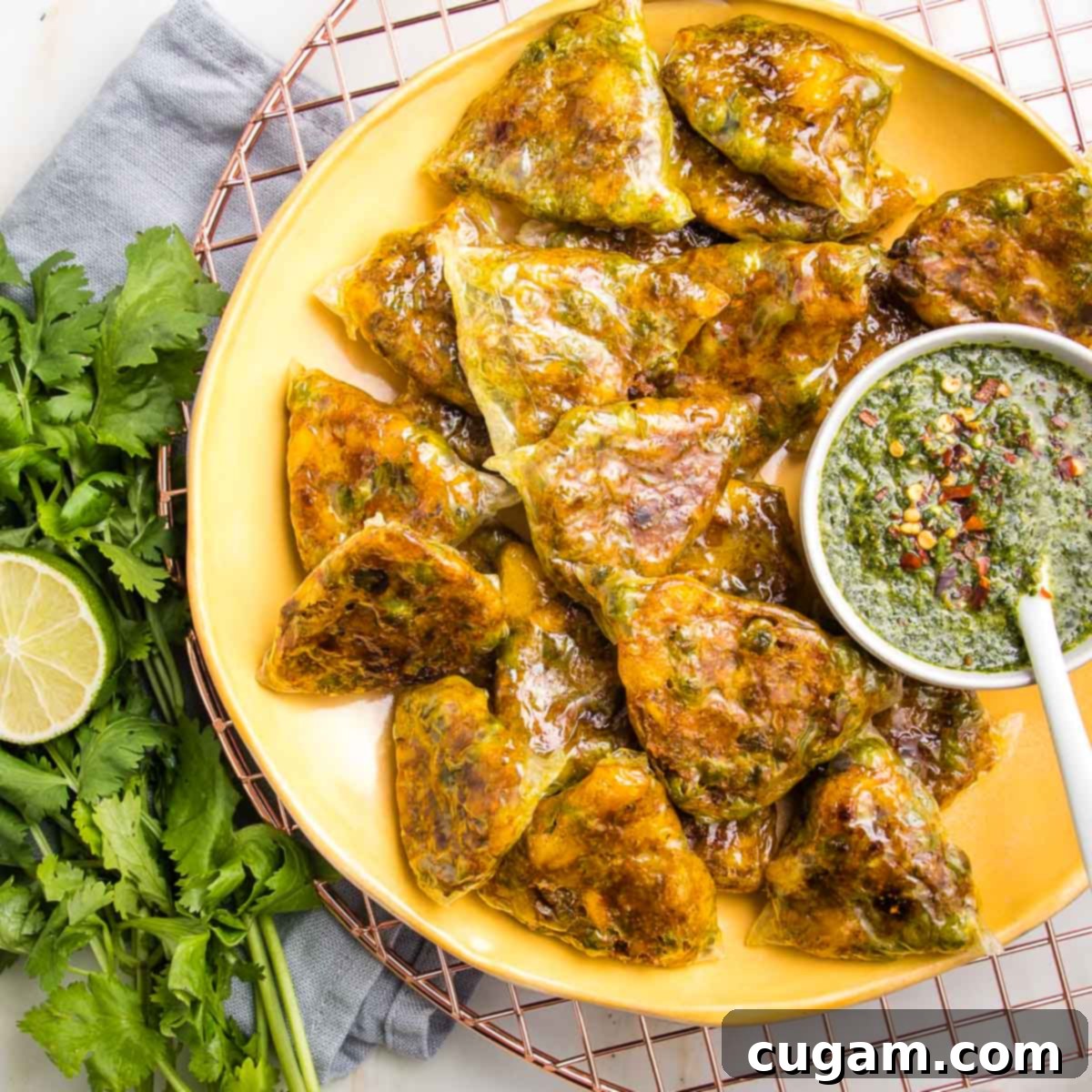
- Mise en Place is Key: Because rice paper wrappers become sticky quickly once wet, have all your ingredients, tools, and the baking sheet ready and within arm’s reach before you start dipping the wrappers. This flow will make the assembly much smoother.
- Keep it Dry: Always have a clean dish towel nearby. Use it to gently dab off excess water from the wet rice paper wrapper before cutting and filling. You can also use it to dry your fingers if they become too sticky.
- Embrace the Learning Curve: If this is your first time working with rice paper, don’t worry if the first few samosas aren’t perfectly shaped. There’s a slight learning curve, but you’ll get the hang of it by the second or third one! If a wrapper gets too sticky or tears, simply scoop the filling back into your bowl, discard the wrapper, and start fresh. It’s no big deal.
- Customize Your Samosa Size: This recipe yields appetizer-sized samosas. If you prefer larger, dinner-sized samosas, simply purchase larger diameter rice paper wrappers. The folding technique remains the same.
- Season to Taste: Don’t be afraid to taste your potato filling before folding! Adjust the spices as desired. If your potatoes are larger than suggested, you might need to add a bit more salt, chili powder, or other spices to achieve your preferred flavor intensity.
- Best Served Fresh: Baked samosas are at their absolute crispiest and most delicious right out of the oven. While you can prep the filling and even assemble the samosas ahead of time, bake them just before you plan to serve to ensure maximum crunch.
- Beware of Turmeric Stains: Turmeric is a wonderful spice but notorious for staining. Be mindful when handling the filling, as it can leave yellow marks on your clothing or countertops. Consider using an older towel for dabbing wrappers, as it might get stained.
- Flavor Variations: Feel free to experiment with your filling! Add finely chopped carrots, bell peppers, or even a touch of grated paneer (if not strictly vegan) for extra texture and flavor. A squeeze of lemon juice in the filling can also brighten the flavors.
Meal Prep and Storage Tips
These baked vegan samosas are fantastic fresh, but with a little planning, you can enjoy them throughout the week or even freeze them for later. Here’s how to manage your meal prep and storage:
- To Serve: For the ultimate experience, serve your crispy baked samosas immediately after they come out of the oven. They make a perfect healthy appetizer when paired with the green chutney or even a mango dipping sauce. For a more substantial meal, make them slightly larger and serve alongside a light side dish like a simple cauliflower rice or a fresh salad.
- To Prep Ahead:
- Samosa Filling: The spiced potato and pea filling can be made up to 3 days in advance. Store it covered in an airtight container in the refrigerator. This saves a lot of time on the day you plan to bake.
- Cilantro Chutney: The green chutney is incredibly robust and can be prepared up to a week in advance. Store it in a sealed jar in the refrigerator. Its flavors will deepen over time.
- Assembled Samosas: You can assemble the samosas on a baking tray lined with parchment paper up to 4 hours before baking. Keep them at room temperature, loosely covered, to prevent the wrappers from drying out or becoming too sticky.
- To Store Baked Samosas: If you have any leftover baked samosas, store them in an airtight container in the refrigerator for up to 2-3 days. Note that the wrappers will lose some of their crispness and become chewier once chilled.
- To Freeze Cooked Samosas: Ensure your cooked samosas are completely cooled before freezing. Arrange them in a single layer on a baking sheet and freeze until solid (this prevents them from sticking together). Once frozen, transfer them to an airtight freezer-safe container or bag, placing parchment paper between layers to prevent sticking. They can be stored in the freezer for up to 3 months.
- To Reheat: To restore their crispiness, reheat baked or frozen samosas in a preheated 375°F (190°C) oven for about 15 minutes, or until heated through and re-crisped. Avoid microwaving, as this will make them soft and soggy.
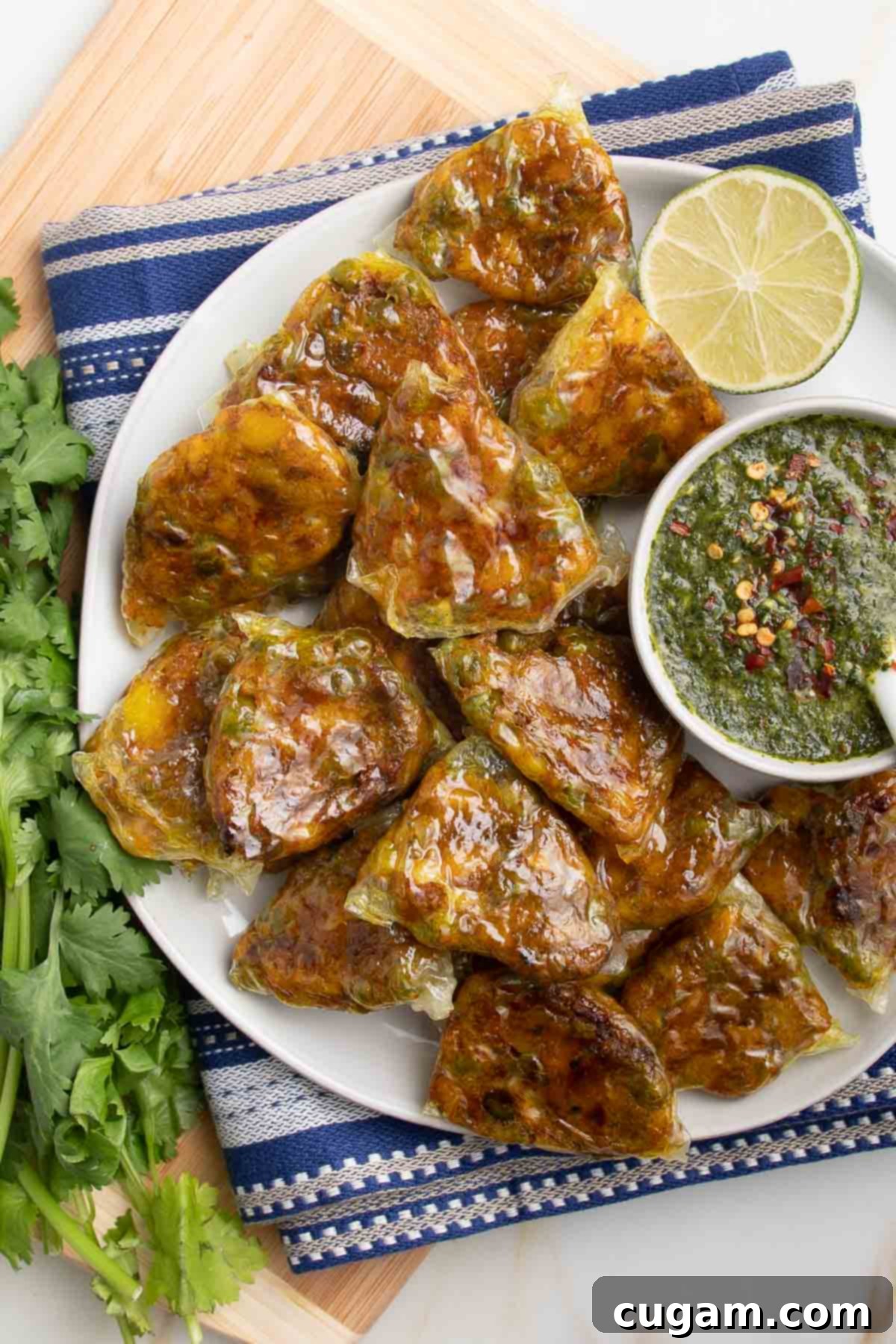
More Healthy and Fun Appetizer Recipes to Try
If you loved these easy baked vegan samosas, you’ll surely enjoy exploring other healthy and delightful appetizer options. Expand your culinary repertoire with these fantastic recipes:
- Vegan Sweet and Sour Meatballs
- Gluten-Free Stuffed Mushrooms
- Veggie Spring Rolls with Peanut Sauce
- No Yeast Flatbread Pizza Recipe
Did you know commenting and rating recipes is one of the best ways to support your favorite food bloggers? If you made this recipe, please consider a five-star rating below and leave a comment. Also, please share your photos on Instagram by tagging me @dkhealthcoach and using the hashtag #debraklein
📖 Recipe

Baked Samosa Recipe
Light and crisp homemade healthy samosas baked in rice paper wrapper. A super tasty, vegan and gluten-free appetizer, served with green chutney.
Rate this Recipe
Pin Recipe
Ingredients
- ½ lb. yukon gold potatoes*
- 1 onion, small dice
- 2 or more cloves garlic, minced, pressed or zested.
- 1 teaspoon ground turmeric
- 1 teaspoon chili powder
- ¼ teaspoon cinnamon
- ½ teaspoon sea salt
- a few grinds black pepper
- 1 cup frozen peas
- optional: 2 Tablespoons fresh cilantro
- 12 rice paper wrappers*
Green Chutney
- 2 cups cilantro, woody stems removed
- 1 cup mint leaves
- 1 lime, zested and juiced
- 2 Tablespoons honey or maple syrup
- 1 Tablespoon diced fresh ginger
- 1 ½ teaspoons cumin
- 1 teaspoon salt
- 1-2 jalapeños (optional, remove seeds for less heat)
Instructions
- Cut potatoes into large dice. Place in a small saucepan, cover with water and cook until tender, but not mushy. About 20 minutes.
- Saute onions in 1-2 Tablespoons water (or veggie broth or olive oil) for 3-5 minutes, until softening. Add the garlic, turmeric, chili powder, cinnamon, salt and pepper and stir constantly while garlic cooks and spices become fragrant. Add another Tablespoon water if the pan becomes too dry.
- Turn off heat and let the onion mixture sit until the potatoes are done. Then add the potatoes to the pan. Use a fork to roughly mash them, then stir the potatoes into the onion mixture until well incorporated. Add the peas and gently mix them in.
- Get yourself set up and ready before beginning to fold the samosas. Preheat the oven to 400°F (200°C). Line a rimmed baking tray with unbleached parchment paper. Fill a shallow dish (like a pie plate) with ¼” water. Have a dish towel (preferably one that is already stained, as the turmeric could leach onto your towel) ready and a wooden board to fold the samosas. And you’ll need a pair of kitchen scissors.
- Dip one rice paper wrapper into the water. Wait 5 seconds. Flip it onto the other side and push down to submerge for about 10 seconds. You want it to be pliable, but not so sticky (like saran wrap) that it sticks to itself.
- Dab the wrapper onto your dish towel to prevent dripping, then cut in half so you have two half moons. Place each half separately onto the wooden board with the long edge on top and the curved edge on the bottom.
- Scoop 1 heaping Tablespoon of the potato mixture onto the middle of each half moon wrapper. Start folding by taking the right top edge and bringing it over to the left bottom. Then take the top left edge and bring it over toward the right bottom. You should have a triangle now. The very center will be the top point of the triangle. Fold the bottom edge up and over to seal the samosa.
- As soon as each samosa is folded into a triangle, move it to the prepared baking tray. Continue until all the filling is used. You should be able to make 2 dozen appetizer sized samosas.
- Place the tray in the oven to bake for 20 minutes. Then flip and bake for another 10 minutes. Serve warm with cilantro dipping sauce.
Cilantro Chutney
- Place all chutney ingredients in a food processor or high speed blender. Blend until smooth.
- Taste for seasoning. Squeeze in another lime if you like your green chutney tangy. Add another Tablespoon honey or syrup if you prefer it sweeter. Sprinkle in some crushed red pepper or add more jalapeño if spicy is your jam.
- Add ¼ cup water, one Tablespoon at a time until desired consistency.
- Chutney will stay good in a sealed jar in the fridge for 3 weeks.
Notes
POTATOES: I like Yukon Gold for their yellow flesh that’s sweet and easy to mash. You can use any potato, even sweet potatoes, that you have. I used 3 small potatoes. The exact measurement doesn’t matter. You can always adjust and add more spices if your potatoes are a bit larger.
RICE PAPER WRAPPERS: You’ll be cutting each circle in half to make 2 half moons, so each wrapper will make 2 samosas. You will get at least 24 samosas out of this recipe.
Nutrition
Serving: 1g | Calories: 65kcal | Carbohydrates: 14g | Protein: 3g | Sodium: 213mg | Fiber: 3g | Sugar: 2g
Note
The nutrition calculations were done using online tools. To obtain the most accurate representation of the nutritional information in any given recipe, you should calculate the nutritional information with the actual ingredients you used. You are ultimately responsible for ensuring that any nutritional information is accurate, complete and useful.
Did you make this recipe?
Please leave a review below, then snap a picture and tag me @dkhealthcoach or use hashtag #dkhealtcoach on Instagram so I can see it!!
